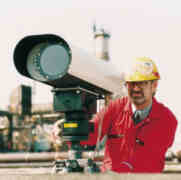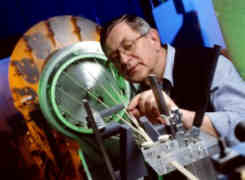
Embargo until September, 6 2001
E-BioSci is a new, next generation scientific information service initiated by EMBO to meet the future needs of researchers in the life sciences and funded by the European Commission with 2,4 million Euro over three years. The service – aimed at establishing Europe’s leadership in one of the most important and fast moving scientific fields of our day – will offer scientists and other researchers new forms of navigation through the dramatically increasing floo

Delta Debugging automates the scientific method of debugging. The basic idea of the scientific method is to establish a hypothesis on why something does not work. You test this hypothesis, and you refine or reject it depending on the test outcome. When debugging, people are doing this all the time. Manually. Delta Debugging automates this process. Read more…

The Problem Considerable progress has been made in basic research and software development for modeling traffic flow. However, user-friendly and affordable services which could prevent a car driver from getting stuck in a traffic jam are not yet as effective as they could be.
Dynamic guidance covering the major highways has already been implemented in many European countries. On secondary roads, and especially across major

Air pollution used to be something you could see and smell. But as air quality standards have tightened, the air over most industrial sites, airports and cities has gradually cleared. Nevertheless, invisible toxic agents such as ethyl benzene, butadiene and styrene continue to pose risks to public health. With a view to detecting and quantifying these agents, Siemens Environmental Systems Limited in Poole, England has introduced UV Falcon. The system consists of a transmitter that projects a UV (ult

Future generations of electric trains may use considerably less power than they do today thanks to the development of the first high temperature superconducting (HTS) cable. To produce the cable, Scientists at Siemens Corporate Technology in Erlangen, Germany started out with micron-sized particles of a brittle ceramic material. The particles were then embedded in a silver alloy. Through repeated rolling stages and annealing, the material was turned into ribbon-shaped wires. To make a cable from suc

Ever find using a product incredibly difficult and frustrating? Lack of product interface design-some have called it the “science of simplicity”–is usually the reason why companies that neglect this may find the consumer marketplace less than receptive-and customers less than satisfied. With this in mind, Siemens has inaugurated its third worldwide User Interface Design Lab. Located at Siemens Corporate Research (SCR) in Princeton, NJ, the lab has responsibility in the U.S. for evaluating user inte

Operations teams have confirmed NASA’s mission to “touch” the Sun survived its record-breaking closest approach to the solar surface on Dec. 24, 2024. Breaking its previous record by flying just…

At the Berlin synchrotron radiation source BESSY II, the largest magnetic anisotropy of a single molecule ever measured experimentally has been determined. The larger this anisotropy is, the better a…

LSU quantum researchers uncover hidden quantum behaviors within classical light, which could make quantum technologies robust. Understanding the boundary between classical and quantum physics has long been a central question…

Microorganisms are everywhere and have been influencing the Earth’s environment for over 3.5 billion years. Researchers from Germany, Austria and Taiwan have now deciphered the role they play in the…

Exploiting an ingenious combination of photochemical (i.e., light-induced) reactions and self-assembly processes, a team led by Prof. Alberto Credi of the University of Bologna has succeeded in inserting a filiform…

A team led by plant biotechnologist Prof Markus Schwarzländer from the University of Münster and biochemist Prof Bruce Morgan from Saarland University has developed new biosensors with which the ratio…

Long gone are the days where all our data could fit on a two-megabyte floppy disk. In today’s information-based society, the increasing volume of information being handled demands that we…

In the search for new materials that can enable more efficient electronics, scientists are exploring so-called 2-D materials. These are sheets of just one atom thick, that may have all…

How simulations help manufacturing of modern displays. Modern materials must be recyclable and sustainable. Consumer electronics is no exception, with organic light-emitting diodes (OLEDs) taking over modern televisions and portable…

Researchers from Osaka University introduced an innovative technology to lower power consumption for modern memory devices. Stepping up the Memory Game: Overcoming the Limitations of Traditional RAM Osaka, Japan –…

Cutting-Edge Framework for Enhancing System Security Researchers at the University of Electro-Communications have developed a groundbreaking framework for improving system security by analyzing business process logs. This framework focuses on…

AQSolotl’s quantum controller is designed to be adaptable, scalable and cost-efficient. Quantum technology jointly developed at Nanyang Technological University, Singapore (NTU Singapore) and National University of Singapore (NUS) has now…